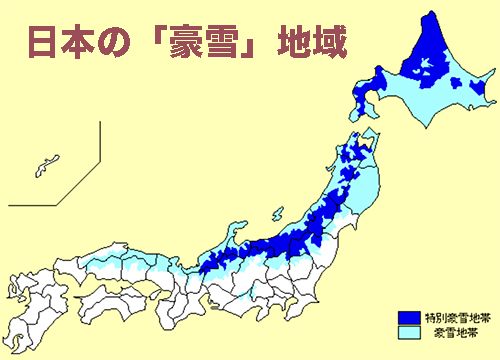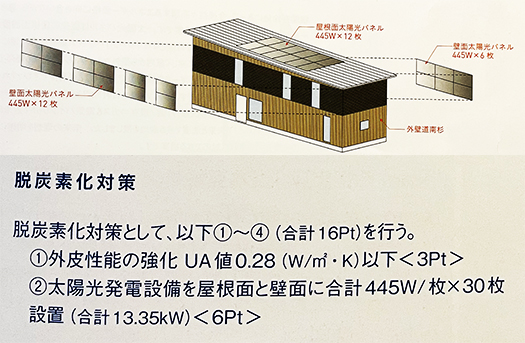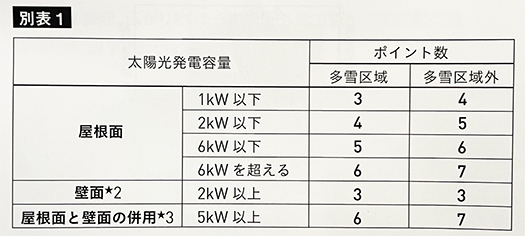


きのう太陽光発電の「壁面設置」についての北海道でのさまざまなチャレンジをご紹介したけれど、エネルギー危機対応としてのPV採用について積雪の問題が立ち塞がっている。
国交省の定めている「多雪区域」の定義とは「建築基準法施行令第86条の規定により、特定行政庁が定める垂直積雪量100cm以上に該当する地域」とされている。この建築予定地の南幌町は130cmとされているので、多雪区域の条件が適用されることになる。
本来、こういった地域に対してエネルギーへの考え方変更を迫るのであれば、国の制度としても予測される困難に対しての制度的対応策が示されるべきだと思うけれど、いまのところは地方自治体の努力にひたすら負っているということは否めない。そういうことは制度の側で追究されるべきとして、現実的には「できること」を考えて社会の変化に対応していくしかない。
上に示した南幌町「ゼロカーボンヴィレッジ」のプラン集でもっともPVを活用した案。(株)キクザワ+弘田亨一設計のコラボによる建築提案住宅例。
緩勾配の無落雪フラットルーフ屋根に445Wパネル12枚、壁面に合計18枚設置で、トータル30枚設置。エネルギーは合計で13.35kWとパワフルなチャレンジ案。キクザワさんの本拠は恵庭市であり、多雪区域外の90cm地域ということもあって、ここでもかなり「攻めた」プランを提案している。同社では積極的にPV活用を進めてきているので、制度側が想定している太陽光発電の「効率」よりも、実際の運転効率実績の「経験知」からこのような判断になっているものと思われる。
寒冷地での実際のエネルギー機器効率を実地検証してきた立場からの提案にはうなずけるものがある。最新の住宅事例を先日見学させていただいたが、換気や暖房機器についてチャレンジングな姿勢を貫かれている。ご自宅を実験場にして、さまざまなエネルギー機器の活用効率について極限的な研究姿勢でとり組まれていて、大いにワクワクさせられた。
このようなチャレンジにはもっともふさわしい地域性は北海道だと言える。厳しい条件の中で、得られる結果は厳しい検証を経てきているのだと考えられるのですね。
多雪区域だからと諦める前に、すこしづつ確かだと思える実績を積み重ねて前を向いて行く方が清々しいとも思える。北海道に移住してきた人びとは後ろを振り返るよりも、前に向かって挑戦していくしかないと思い定める方が多数派だったのだと考えれば、大いに同意できる。イマドキの「フロンティアスピリット」って、案外こういうところで生きているのかも知れない。
English version⬇
The challenge of utilizing PV in “high snowfall areas,” where it is difficult to install PV.
The attitude of boldly taking on the challenge of a harsh external environment with more than 100 cm of vertical snow cover shows the frontier spirit of the Pure-Hokkaido people.
Yesterday I introduced various challenges in Hokkaido regarding “wall-mounted” solar power generation, but the problem of snow accumulation is still an obstacle to the adoption of PV as a response to the energy crisis.
The Ministry of Land, Infrastructure, Transport, and Tourism defines a “heavy snowfall area” as “an area with a vertical snow accumulation of 100 cm or more as specified by a specified administrative agency in accordance with Article 86 of the Building Standards Law Enforcement Order. Since the proposed building site in Minamihoro Town is located in an area with a vertical snowfall of 130 cm, the conditions of a heavy snowfall area would apply.
If the government is going to force these areas to change their approach to energy, it should also provide institutional measures to deal with the anticipated difficulties, but it is undeniable that at the moment the local governments are solely responsible for their own efforts. While such matters should be pursued on the institutional side, in reality, we have no choice but to respond to social changes by considering “what we can do.
The plan shown above is the one that makes the most use of PV in the collection of plans for the “Zero Carbon Village” in Minamihoro Town. (An example of a proposed house built in collaboration with Kikuzawa Corporation and Toruichi Hirota Design.
A total of 30 panels were installed: 12 445W panels on the gently sloped, no-snowfall flat roof, and a total of 18 panels on the walls. The total energy is 13.35 kW, a powerful challenge proposal. Kikuzawa’s home base is in Eniwa City, an area with 90cm of snow outside of the heavy snowfall zone, so they are proposing a very “aggressive” plan here as well. Since the company has been actively promoting the use of PV, it is assumed that this decision is based on “empirical knowledge” of actual operational efficiency results, rather than the “efficiency” of PV power generation as assumed by the system.
This is a nod to the proposal from a position that has actually verified actual energy efficiency in cold regions. I recently had a chance to visit their latest home, and they are taking a challenging stance on ventilation and heating equipment. I was very excited by their extreme research into the efficiency of various energy equipment, using their home as a testing ground.
Hokkaido is the most suitable region for this kind of challenge. You can assume that the results obtained under the harsh conditions have been subjected to rigorous verification.
Before giving up because of the heavy snowfall, it would be more refreshing to look forward with a little bit of certainty to the results we have accumulated. I agree that the majority of the people who moved to Hokkaido were determined to move forward and take on challenges, rather than looking backward. The “frontier spirit” of today’s people may be more alive in such places than one might think.
Posted on 3月 16th, 2024 by 三木 奎吾
Filed under: 未分類







コメントを投稿
「※誹謗中傷や、悪意のある書き込み、営利目的などのコメントを防ぐために、投稿された全てのコメントは一時的に保留されますのでご了承ください。」
You must be logged in to post a comment.